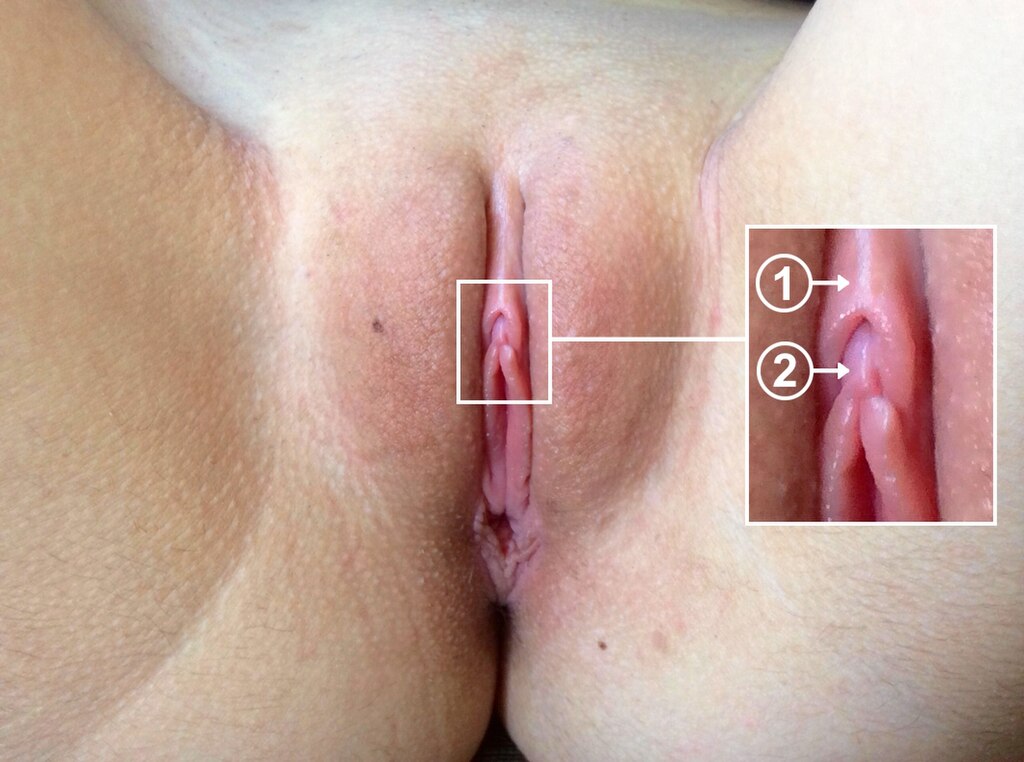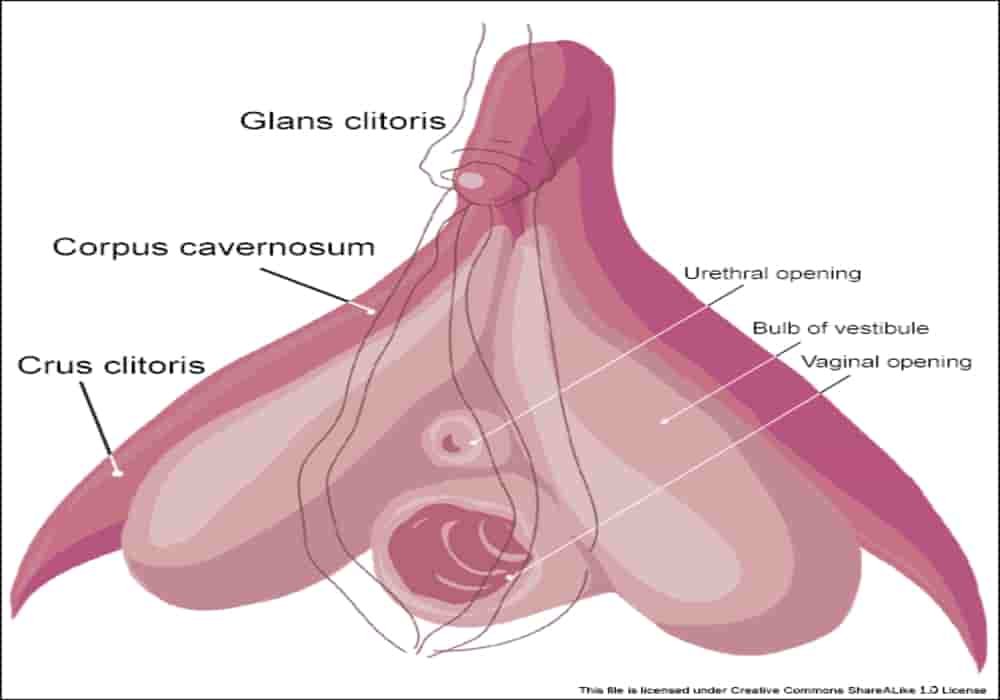Clitoris
Located inside the vulva, the clitoris is an erogenous organ of the female genitalia. What is hier role? Her size? Why does it give pleasure when it is caressed? What is the clitoral orgasm? Uninhibited dive into the mysteries of this organ.
This organ is structurally and functionally similar to the penis in the male reproductive system, except that the clitoris does not contain the urethra and does not play a role in urination.
The content of this page discusses the anatomy of the human body in terms of science. Which may contain a sexual element, which may be extreme for some people, especially those under 18 years of age. Please exit If you are not comfortable with this.
Where is it?
Where the labia minora meet, inside the vulva, is the clitoris.

Three-dimensional representation of the clitoris with its associated erectile tissue system.
1=Glans clitoridis; 2=Corpus clitoridis; 3=Corpus cavernosum clitoridis; 4=Bulbi clitoridis (Bulbi vestibuli); 5=Urethra; 6=Introitus vaginae; 7=Vagina; 8=Uterus; 9=Vesica urinaria. Helen O’Connell, CC BY-SA 4.0, via Wikimedia Commons
External parts of the clitoris
The glans clitoris is the name for the outer part of the clitoris, the one most people call the “clitoris”.
It is the size of a pea and is located above the urethra. The glans is the most innervated area of this place, so it is extremely sensitive to touch.
Unlike the rest of it, the glans does not swell or grow during sexual stimulation because it contains no erectile (stretchable) tissue.
Just above or on the glans is the clitoral hood, which is formed by both sides of the labia minora. The size and the way the clitoral hood is covered can be very different from person to person.
Internal parts of the clitoris
Most of the clitoris is usually invisible.
The body of the clitoris is connected to the glans of the clitoris. The body of the clitoris extends into your pelvis and attaches to your pubis by ligaments.
From the body (located in front of the urethra), this part divides in two to form the paired crura (which are like the “legs” of the clitoris) and the bulbs of the vestibule. These bulbs extend through and behind the labia, passing through the urethra, the vaginal canal, and towards the anus.
The bulbs and crura contain erectile tissues that swell with blood when arousal rises. By inflating on either side of the vaginal canal, they increase the lubrication of the vagina, while increasing stimulation and sexual sensations. This expansion of the clitoral tissue can also cause pressure on the anterior part of the vaginal canal.

(1) Clitoral hood and (2) Clitoris CRW09, CC BY-SA 3.0, via Wikimedia Commons
Why is the clitoris erogenous (producing sexual excitement)?
Like the male penis, it becomes erect when stimulated and aroused. The clitoris has between 8,000 and 10,000 sensory sensors, while the male glans has 3,000 to 4,000 on average.
“The base of the clitoris corresponds to the G-spot”
This part is a very innervated and vascularized erogenous zone and it particularly sensitive. Its erectile tissues fill with blood when aroused. The mode of stimulation, whether it’s masturbation or caressing with a partner, varies between women, with some preferring very light caresses, and others more pressure.
Depending on the position of the partners during penetration or caressing the area, the clitoris is very sensitive to excitement and participates in the power of orgasm. Located on the front of the vagina, the base of the clitoris corresponds point G (or zone G), We speak rather of Zone G because it affects the nervous tissues of the vagina, urethra and base of the clitoris.
How to stimulate the clitoris
Each person is different and so are the erogenous zones, preferences and desires. We cannot stress this enough! There is no “best way” to stimulate it – you have to experiment for yourself.
That said, here are some tips to help you and your partner get off on it.
1. Set the mood. Sit in a place where you feel comfortable.
If you’re with a partner, creating the perfect atmosphere might consist of making out, making time for foreplay, and exploring each other’s bodies.
If you’re solo, feel free to get comfortable and stimulate any other erogenous zones on your body (like your nipples). Don’t forget your mind – if you feel like it and your imagination isn’t particularly turning you on this time around, you can also get in on the action with porn or sexy literature.
2. Discover the area near it and introduce yourself.
Use whatever you want: your fingers, your partner’s fingers or mouth/tongue, or another (clean) object, such as a sex toy. You can also try using a shower head, a vibrator, or even rubbing your underwear on something, like a pillow. Once you feel comfortable with the area around the clitoris and are ready, it’s time to directly stimulate the clitoris.
3. Begin by gently and gently touching or stroking the clitoris.
This organ isn’t a magic button, so just pressing it (for most people) won’t instantly produce an orgasm. Also, don’t pretend to be a DJ by forcefully rubbing it back and forth – no one likes to be taken the wrong way.
4. Take your time.
It’s a small area, and it can seem intimidating at first. “How can I be creative enough to stimulate such a small area of skin? » Listen to your body, or your partner, and pay attention to how you feel.
You can try gentle back and forth motions, small circular motions, or even light tapping.
Also stimulate the clitoral hood – remember that it too has nerve endings and the body of the clitoris curves behind it, before lodging in your pelvis. Make a first small assessment with yourself or with your partner: do you like it?
5. You can start playing with pressure, speed, body parts (like tongue if you are with a partner), toys or vibrations.
In general, when people are aroused, they begin to produce arousal fluid, which can help make clitoral and vaginal stimulation more enjoyable.
6. Remember to add a good dose of lube.
For some people, by adding more lube will give more good sensations.
7. You can also try stimulating the clitoris from the inside using a penis, a sex toy or your fingers.
Not everyone will be stimulated or even reach an orgasm the first time, or every time, they have sex or masturbate – and that’s okay.
The only really important thing is that you have fun. If you’re not having fun, don’t.
Read also: Sexual Fetish Names | Paraphilia (Sexual Disorder), Clinical Names and Examples
Clitoris and G-spot search
Both its anatomy and its function – is hotly debated. Taboos around women’s sexuality and pleasure have contributed to the lack of research on these topics. But as the taboos surrounding them are lifted, hopefully further research will lead to a better understanding of the clitoris.
The existence or function of the G-spot is also not 100% clear. Some research claims that it may be associated with female ejaculation (also known as squirting or squirting).
Other researchers suggest that the G-spot is not necessarily an actual physical structure, but rather the place where the sides of the vestibular bulbs of the clitoris come into contact with the anterior wall of the vagina.
This suggests that a “vaginal orgasm” is actually always related to this part – because every movement during penetrative vaginal sex or the contraction of the pelvic muscles can stimulate it.
The size
The outer part of the clitoris, the glans of the clitoris, as well as the clitoral hood, can vary greatly from person to person.
Androgen exposure can cause increase in its size at any time in life, including during embryonic development, childhood, and adulthood. When the size of it, is large enough to be considered abnormal, it is called an enlarged clitoris.

Closeup photograph of a vulva with a large clitoris. It is engorged and enlarged. Serena Solano, source: https://www.flickr.com/photos/193819970@N05/51813464080, CC BY 2.0, via Wikimedia Commons
The clitoris and the penis – a common origin
The penis and the clitoris have a similar structure. In fact, they both come from the same type of fabric (5).
At eight weeks of fetal development, the male DNA Y chromosome will activate the differentiation of genital tissue to develop into a penis, instead of a clitoris. Many parts of the clitoris are similar to those of the penis, but they differ in shape and size, and are located in different places.
Is the clitoris a small penis or the penis a giant clitoris?
Everyone reaches orgasm differently. Experimenting with masturbation or different sex positions—along with a good dose of patience—can help you find what works best for you.

A comparison between the external human female and male genitalia. This comparison features an erect clitoris and a flaccid penis. The penis is circumcised, but it is displaying shrinkage. The glans clitoris is developmentally homologous to the glans penis. They both contain the same amount of nerve endings, but the nerve endings of the glans clitoris are packed more densely because it is a smaller structure so it tends to be more sensitive than the glans penis. The labia majora and scrotum are also biological homologues. While the labia majora lies flat beneath the clitoris, the scrotum bulges beneath the penis because it contains testicles. Kriptzone, CC BY-SA 4.0, via Wikimedia Commons
Female Condom | Advantages and Disadvantages ? | How to use it, accidents
Sources: PinterPandai, Inner Body, Wikipedia, Very Well health, World Health Organization (WHO)
Photo credit (main picture): Amphis (CC SA 1.0) via Wikimedia Commons



